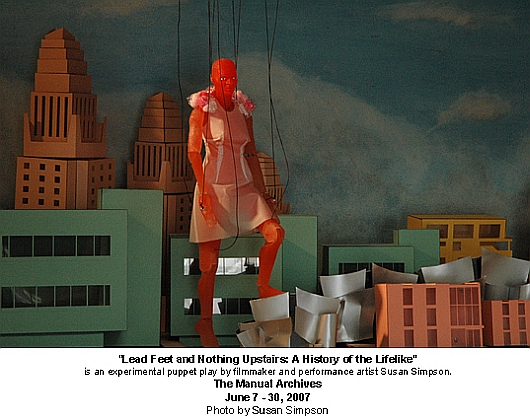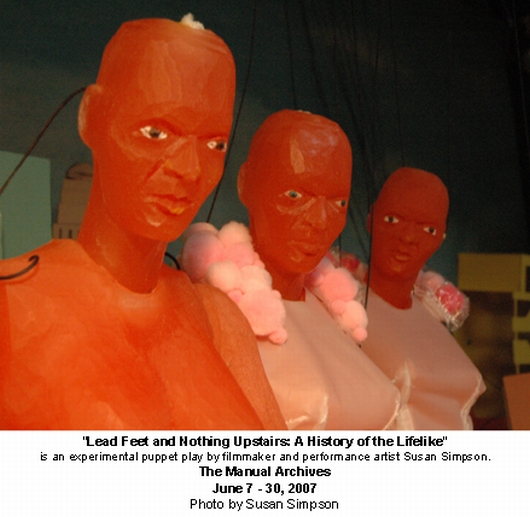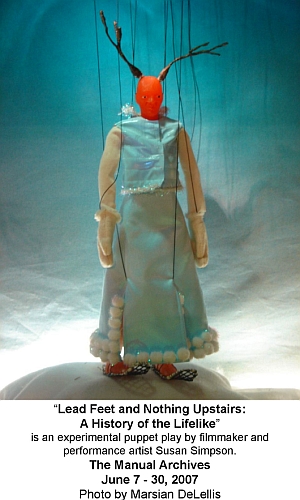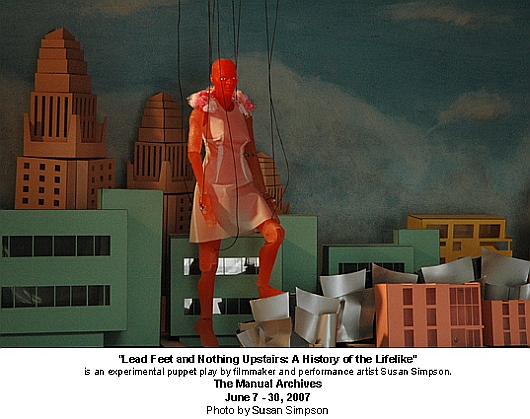
June 7-30th @ Manual Archives ~ 3320 West Sunset Blvd. Silverlake, CA 90026
I've always been fascinated by miniatures, from the tiny pieces of furniture my grandpa bought to make dollhouses in his 80's, to the micro-worlds used to sell kung-fu gripped action figures on TV commercials, to shrunken products like minute bottles of Scope and those short fat cans of Coke. The movie Being John Malkovich showed me what might be possible in the world of puppetry, with tiny, human-like movements carrying great sadness, beauty, and weight. With the notable exception of a childhood visit to downtown's Bob Baker's Puppet Theater, I have been bypassed by most recent puppet productions in Los Angeles, left to wonder at the wee bits of grace I might have missed.
So it was, I jumped to see Lead Feet and Nothing Upstairs: A History of the Lifelike, written and directed by Susan Simpson, with puppetry provided by 3-4 adorable actors ripped straight from a contemporary Benneton ad. Indeed the puppetry on display went from slightly bungling to practically string-free smooth, revealing an intricate, detailed art form with the potential to move and inspire, focusing theater's ability to reflect the audience's world in the most objective of ways, as each house member grows to the size of a Titan to laser-beam in on the small action with bated breath.

Lead Feet is the story of female triplets (played by mini-mannequins who resemble hairless burn victims) raised by a grandma whose folk tale convinces them that only one is original and the other two mere replicants of the first. Taking the story literally, the blank-faced, bald-headed puppet triplets take a Siddhartha-like journey, dovetailing in and out of each other's lives to explore concepts of origin, individuality, influence, and place. The girls eventually land in a shallow Los Angeles, where their presence causes a proliferation of cloning in buildings, clubs, nature, and entertainment, swelling the city's size dramatically.

The power of puppetry was present in the tiny detailed face of the crone-like grandmother, whose miniscule movements conveyed profound love and protection, whether reaching out to nothingness for a hug or spreading a heaven-sent blanket over her wards. Settings and details are in fact the play's biggest spectacle; tiny tree branches, moody lighting, and falling lint create frames of Kurosawa-esque proportions while simulating nature in small style. Outer space hasn't looked as frighteningly lonely since 2001. Eliciting the most laughs and awe were the scenes set in our own city of Los Angeles. An army of tiny Disney Concert Halls, floating palm trees, and City Halls pop up, cloning themselves as the sisters traverse the municipality, a possible comment on development relating to transplants or the nature of popular things to shortly become overexposed.
Sadly, I felt the play assumed that everyone shares the same love-hate and stereotypes about LA; that it is a soul-less, history-void gargantuan of followers where people come to find themselves in trends and acceptance in identical identities. Finding identity in exteriors surfaces constantly as wandering Angelenos, resembling Faker He-Man dolls, recognize their dopplegangers through matching labels, brand preferences, and appearences. Contrasted with the triplets' identical genetics, yet constant stress over who is more original, makes a nice juxtaposition to the random individuals feeling unloved and alone. The embodying of LA and its denizens as feminized, overly-materialistic, and shallow is hackneyed, as many sympathetic giggles as it elicits from a variously transplanted crowd missing their MidWest cows and East Coast pizza.
Spread out on a map of the city, the triplets finally decide to leave and return home in conquest of the area. As we've been told, one can never go home again, and the play successfully details how things and people constantly morph: growing, cloning, shrinking, and dying. What was once your's is now produced for general consumption, gone, or simply not in need of you anymore.
A lot of the themes revolve around being your own person, while simultanesously needing others as part of your strength and identity. The sisters' unification holds the power of creation while their separation deals loss and emptiness in spades. There are many juxtapositions found in the set-up of triplets looking for origniality through separating while strangers seek glory by merging identities on a broad scale. Perhaps Los Angeles, with its huge transplant population and A-list strivers, makes a good battlefield for a war with ourselves, and certainly not every play has to touch on the 3rd-and-1st world divide that seems to define us much more than Rodeo price tags.
The scenes are short and simple but certainly not few, with a sweet, ambling feel emanating while the story abstractedly winds around its concepts. This feeling is aided by Emily Lacy and Eric Lindsay, a bluegrass duo tickling banjo and harp strings, also filling in agonizingly-long transitions with songs that would not be out of character on Gillian Welch's first album. Maybe the throwback to an older era helps the audience to find originality in long-gone legends? But as gorgeous and thought-provoking as the songs are, they have a hard time easing the feeling of numb-butt that comes from waiting for the loose story to proceed. The story loses its pacing easily through such pauses, probably the biggest complaint I have about this heartwarming exploration of identity.
When viewed from the outside, this enjoyable play is very successful in terms of bringing up issues of identity. It is a purposefully challenging work, with no linear structure, an evasive text, and a strange, otherworldly feel. It is mesmerizing to watch, but the questions it raises are not directly answered whether through script or experience, making me wonder whether this was a fully realized experimental drama or a fantastic idea that the author herself has trouble taking position on. At times I wondered whether the puppets were in need of a show or whether the show was really needing puppets to say what it has to.
The debut of this play is also this teensy theatre's debut and I think a lot of the rougher transitions will be smoothed out so the story's strength will come across better in future shows. I also had wished the engaging narrator was on the same side of the stage as the musicians, as so many people lingering around the stage made them look like puppet techs awaiting tangled strings, and took away from the cool experience of watching a puppet world breathe from a hole in the wall. Suspension of suspension of disbelief.
Overall, if puppets and miniatures interest you, you should go see this play! It is certainly a fun trip with great visuals and tunes. If deep questions of identity and originality float your boat, you are even more stoked. Susan Simpson has presented us with a brave and challenging exploration of identity, family, and place. Oh, and plentiful puppets!







